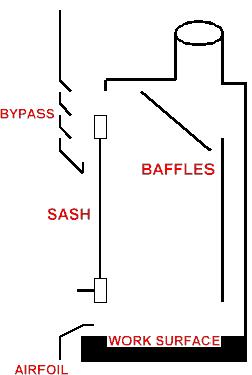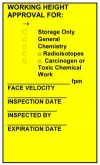University of Arkansas at Little Rock
Policy Name: Laboratory Fume Hood Performance Criteria and Certification Protocol
Policy Number: LR 701.22
Effective Date: January 1, 2009
Revised Dates: September 24, 2008; January 1, 2009; November 3, 2023
Most Recent Review Date: November 3, 2023
Policy
Application
- Laboratory fume hoods are used to prevent harmful exposure to hazardous substances.
- This protocol is to be used by UALR in-house personnel (e.g., EHS, HVAC) and contractors installing new fume hoods during the commissioning phase of new buildings/renovations.
- This document does not apply to biosafety cabinets or other exhausted enclosures.
Definitions
Laboratory-Type Hood. A device enclosed except for necessary exhaust purposes on three sides and top and bottom, designed to draw air inward by means of mechanical ventilation, operated with insertion of only the hands and arms of the user and used to contain hazardous substances.
Hazardous Substance. One which by reason of being explosive, flammable, poisonous, an irritant, or otherwise harmful is likely to cause injury or illness.
Hood Components:
Airfoil. Found along the bottom and sometimes side edges, airfoils streamline airflow into the hood preventing turbulent eddies at the face that can carry vapors out of the hood. Bottom airfoils also provide a space for room airflow when the sash is completely closed.
Baffles. Moveable or adjustable petitions used to create slotted openings along the back of the hood body. Baffles help to keep to a uniform airflow across the face of the hood, which eliminates dead spots and optimizes capture efficiency.
Sash. A moveable, see through barrier that closes or opens the face of the hood.
Work Surface. Generally a laboratory bench top or floor in the case of a walk-in hood. The area under the hood where the apparatus and equipment is placed. Caution must be exercised if the work surface or hood body is made of transite, an asbestos containing material.
Bypass. Grill opening above the face of the hood that helps to maintain a constant face velocity independent of the sash position. When the sash is lowered air flows in through the bypass and the hood face. When the sash is raised it blocks the bypass.
Use
Observation of the laboratory hood environment, maintenance, and work practices can provide an indication of proper exposure control performance. For example, if the sashes of the hood are left open during operation of the research activity, the hood is likely to reduce its functional effectiveness. Laboratory fume hood performance can also be compromised by the following factors:
- Equipment blocking airflow to slots in baffle.
- Equipment placed within 6″ from the plane of hood face.
- Hood sash or panels not replaced after equipment setup completed.
- Cross drafts – can be due to ventilation supply ducts, personnel traffic, or blowers/exhaust related to nearby equipment.
- Maladjustment of exhaust dampers.
- Worker leaning into the hood.
- Leaks in exhaust ducting.
- Turning off the hood fan during actual hood use.
New Laboratory Fume Hoods or Other Special Purpose Hoods
New Equipment – New Facilities and Additions to Existing Facilities
The project’s contractor is responsible for the initial certification and balancing of the system using this protocol.
University faculty/staff is responsible for informing the Environmental Health and Safety Office (EHS) or Central Utilities when new laboratory fume hoods are coming on line.
Unauthorized Equipment
During the annual laboratory fume hood survey, EHS should be notified if any new fume hoods are installed (or removed/out-of-service) so that the equipment can be included (or excluded) in the Laboratory Fume Hood Survey Program and to determine if this additional equipment has created an unbalance in the building’s HVAC laboratory exhaust systems.
Performance Criteria
To ensure proper laboratory fume hood exposure control performance, each of the following criteria must be observed:
Quantitative Assessment Criteria
Laboratory fume hoods shall provide a minimum average effective face velocity of 100 feet per minute (fpm), with a minimum 80 fpm at any point.
Qualitative Assessment Criteria
Laboratory fume hoods shall maintain an inward flow of air at all openings, which shall be demonstrated using smoke tubes or other suitable qualitative methods.
Air Flow Indicator (where applicable)
An airflow indicator shall be located so that it is visible from the front of the fume hood. Follow manufacturer’s procedures for calibration during installation. Follow manufacturer’s schedule for periodic calibration and maintenance parameters thereafter.
Performance criteria for various airflow indicators are as follows:
- FPM Readout: Average readout is 100 fpm.
- Audio/Visual Alarms: Go into alarm mode if average face velocity drops to 80 fpm.
Frequency of Certification
Laboratory fume hoods used to prevent harmful exposures are required to be certified:
- Annually, at a minimum.
- Whenever a laboratory fume hood has been modified.
- Whenever the exhaust duct system connected to a hood has been modified.
Equipment/Materials Required for Certification
- Thermal anemometer (calibrated as specified by manufacturer).
- Titanium tetrachloride, dry ice in water, or other means of visualizing airflow.
- Tape measure.
- Laboratory Fume Hood Survey Forms.
Certification Procedure
To attain certification, a laboratory fume hood must pass both the quantitative and qualitative evaluation.
Quantitative Evaluation – Face Velocity Measurement
- Position the sash at the 18″ height.
- Set a simple grid pattern with grid intervals of 1 foot or less.
- Locate thermal anemometer at center of every segment and measure/record velocity.
- Calculate average face velocity and identify minimum value.
- If average face velocity is greater than or equal to 100 fpm, with a minimum of 80 fpm at any point and a maximum average of 350 fpm the unit has PASSED the quantitative evalution.
- Record all collected data on the Laboratory Fume Hood Survey Form.
Qualitative Evaluation – “Smoke Test”
- Generate “smoke” in direction perpendicular to exhaust flow from locations of containment.
- Generate “smoke” around the perimeter of the designated face, and any other location within the fume hood where turbulent airflow is thought to exist (i.e., around any large obstructions).
- If the smoke is contained within and exhausted from the fume hood, the unit has PASSED the qualitative evaluation.
- Record all collected data on the Laboratory Fume Hood Survey Form.
Air Flow Indicator (where applicable)
- Record the type and condition of airflow indicator on the Laboratory Fume Hood Survey Form.
- If the air velocity indicator is not functioning, contact EHS to issue work order to evaluate if it is out of calibration, broken, etc., and to repair it.
For units that PASS both the Quantitative and Qualitative Evaluations
- Document that unit has passed performance inspection on the Laboratory Fume Hood Survey Form and affix a yellow certification sticker. The unit is certified for use to prevent harmful exposures to hazardous substances.
- The certification sticker marks sash height positions to show the maximum opening at which the hood performance was certified.
For all units that FAIL, immediately:
- Inform users, faculty/lab manager, and department that the unit has failed performance inspection and CANNOT be used for containment of hazardous materials until the unit has been certified.
- Document that the unit has failed performance inspection on the survey form.
- Affix a RED DANGER STICKER to hood stating that it CANNOT be used for preventing harmful exposures to hazardous chemicals.
- If fume hood appears to have failed certification due to improper hood use/setup (i.e., due to equipment blocking baffles), indicate as such on the survey form and communicate to the laboratory manager for correction prior to any retesting.
- If fume hood appears to have failed certification due to mechanical deficiencies, immediately contact Physical Plant to initiate repairs to reduce hood downtime.
- Repeat performance evaluations after necessary corrections have been made.
Source: Environmental Health and Safety, January 1, 2009
Status: Decommissioned
Approved By: Environmental Health and Safety Committee
Originator:
Custodian: Environmental Health and Safety


